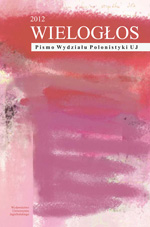Porządkowanie awangardy
A New Typology of The Avant-Garde – an Outline
Author(s): Michalina KmiecikSubject(s): Literary Texts
Published by: Wydawnictwo Uniwersytetu Jagiellońskiego
Keywords: avant-garde; modernism; typology
Summary/Abstract: The article is an attempt at formulating a new typology of the avant-garde in its different modes of functioning. The starting point is the assumption that experimental art at the beginning of the twentieth century was first and foremost the answer to sociocultural changes and the resultant crisis of representation. Four types of attitude are proposed: the socio-affirmative one constitutes an apotheosis of the crisis, which becomes a springboard for the emergence of a new cultural era. Representatives of this stance believe in the possibility of creating entirely new means of expression or conventions and embrace the ideology of progress. The decadent type is a continuation of the Adornian aestheticism; it is characterized by melancholy and the awareness of the impossibility of overcoming the crisis, which often takes on a form of controlled chaos and tragic tomfoolery. The surrealist type tries to create an alternative reality for art, which would liberate it from its cognitive limitations. Finally, the aesthetic-religious type is characterized by the experience of past aesthetics, where the need for beauty is notoriously undermined by the awareness that the means of representation have worn out and the truth is hidden. It is often expressed by yearning after an ineffable sacred, which is not so much lost as eternally ungraspable, hidden and absent.
Journal: Wielogłos
- Issue Year: 2012
- Issue No: 12
- Page Range: 105-125
- Page Count: 21
- Language: Polish

